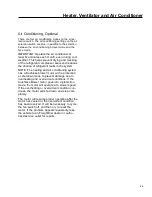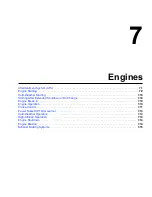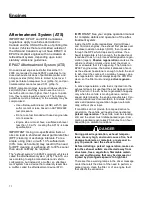
5.
To adjust cruise speed down, push the RESUME
button and hold it in until the vehicle decelerates
to the new speed, as desired.
Power Takeoff (PTO) Governor
Front Engine Power Take Offs (PTO) are devices
used to tap into engine power to run auxiliary de-
vices. Common uses are vehicles with hydraulic
pumps which power additional equipment. The fol-
lowing instructions are general guidelines for operat-
ing a PTO.
1.
Set the parking brake. Shift the transmission to
neutral.
2.
Press the dash PTO switch. Release the switch
when the light begins to blink.
When the light comes on steadily, the PTO is
engaged and ready to operate. In stationary
mode, the vehicle must remain in neutral with the
parking brake set.
3.
To activate the mobile mode, shift from neutral to
reverse, 1st, or 2nd gear. The clutch will open
and the PTO will disengage for a moment.
4.
Touch the throttle pedal to close the clutch and
engage the PTO in mobile mode. The PTO may
be operated with the transmission in the follow-
ing gears only: R-N-1-2.
NOTE: Do not attempt to change gears while
the vehicle is moving. The transmission will ig-
nore the request.
5.
To end the mobile mode, bring the vehicle to a
stop. The clutch will open and shut off power to
the PTO.
6.
To resume stationary mode, shift to neutral. The
PTO will engage.
7.
To end stationary mode, press the dash switch.
When the light in the switch goes out, power to
the PTO is shut off. Shut down the engine.
Cold-Weather Operation
Satisfactory performance of a diesel engine operating
in low ambient temperatures requires modification of
the engine, surrounding equipment, operating prac-
tices, and maintenance procedures. The lower the
temperature, the greater the amount of modification
required. For service products approved for use in
cold weather for your engine, see the engine manu-
facturer’s engine operation manual, supplied in the
vehicle documentation package.
If satisfactory engine temperature is not maintained,
maintenance costs will increase due to greater en-
gine wear. If the engine coolant temperature be-
comes too low, raw fuel will wash the lubricating oil
off the cylinder walls and dilute the crankcase oil,
causing all moving parts of the engine to suffer from
poor lubrication.
If the engine is in good mechanical condition and the
precautions necessary for cold-weather operation are
taken, ordinary cold weather will not cause difficulty
in starting, or loss of efficiency.
The following points are important to observe when
operating in cold weather:
•
Check for cracks in the batteries, for corrosion
of the terminals, and for tightness of the cable
clamps at the terminals.
•
Charge the batteries to full capacity. Replace
any battery that is damaged.
•
If so equipped, turn off the load disconnect
switch after the engine is shut down, to prevent
battery discharge.
•
Have the alternator output checked at an au-
thorized service provider.
•
Check the condition and tension of the drive
belts.
•
Refer to the engine manufacturer’s engine op-
eration manual for recommended heaters, low-
viscosity lubricating oils, wintergrade fuels, and
approved coolants.
A winterfront may be used to improve cab heating
while idling. If a winterfront is used, at least 25% of
the grille opening should remain open in sectioned
stripes that run perpendicular to the charge-air-cooler
tube-flow dirrection. This assures even cooling
across each tube, and reduces header to tube
stress, and possible failure. Winterfronts should only
be used when the ambient temperature remains
below 10°F (-12°C).
High-Altitude Operation
Engines lose horsepower when operated at high alti-
tude because the air is too thin to burn as much fuel
as at sea level. This loss is about three percent for
Engines
7.13










































